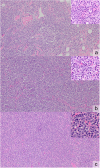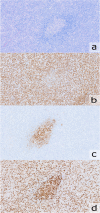The many faces of nodal and splenic marginal zone lymphomas. A report of the 2022 EA4HP/SH lymphoma workshop
- PMID: 37656249
- PMCID: PMC10542713
- DOI: 10.1007/s00428-023-03633-3
The many faces of nodal and splenic marginal zone lymphomas. A report of the 2022 EA4HP/SH lymphoma workshop
Erratum in
-
Correction to: The many faces of nodal and splenic marginal zone lymphomas. A report of the 2022 EA4HP/SH lymphoma workshop.Virchows Arch. 2023 Sep;483(3):437. doi: 10.1007/s00428-023-03646-y. Virchows Arch. 2023. PMID: 37695411 Free PMC article. No abstract available.
Abstract
Session 3 of the lymphoma workshop of the XXI joint meeting of the European Association for Haematopathology and the Society for Hematopathology took place in Florence, Italy, on September 22, 2022. The topics of this session were splenic and nodal marginal zone lymphomas, transformation in marginal zone lymphomas, and pediatric nodal marginal zone lymphomas and their differential diagnosis as well as related entities. Forty-two cases in these categories were submitted to the workshop, including splenic lymphomas (marginal zone and diffuse red pulp lymphomas), transformed marginal zone lymphomas (splenic and nodal), nodal marginal zone lymphomas with increased TFH-cells, and pediatric nodal marginal zone lymphomas. The case review highlighted some of the principal problems in the diagnosis of marginal zone lymphomas, including the difficulties in the distinction between splenic marginal zone lymphoma, splenic diffuse red pulp lymphoma, and hairy cell leukemia variant/splenic B-cell lymphoma with prominent nucleoli which requires integration of clinical features, immunophenotype, and morphology in blood, bone marrow, and spleen; cases of marginal zone lymphoma with markedly increased TFH-cells, simulating a T-cell lymphoma, where molecular studies (clonality and mutation detection) can help to establish the final diagnosis; the criteria for transformation of marginal zone lymphomas, which are still unclear and might require the integration of morphological and molecular data; the concept of an overlapping spectrum between pediatric nodal marginal zone lymphoma and pediatric-type follicular lymphoma; and the distinction between pediatric nodal marginal zone lymphoma and "atypical" marginal zone hyperplasia, where molecular studies are mandatory to correctly classify cases.
Keywords: Marginal zone lymphoma; Marginal zone lymphoma transformation; Pediatric nodal marginal zone hyperplasia; Pediatric nodal marginal zone lymphoma; Splenic diffuse red pulp small B-cell lymphoma; Splenic marginal zone lymphoma.
© 2023. The Author(s).
Conflict of interest statement
The authors declare no competing interests.
Figures




Similar articles
-
Indolent lymphomas in the pediatric population: follicular lymphoma, IRF4/MUM1+ lymphoma, nodal marginal zone lymphoma and chronic lymphocytic leukemia.Virchows Arch. 2016 Feb;468(2):141-57. doi: 10.1007/s00428-015-1855-z. Epub 2015 Sep 28. Virchows Arch. 2016. PMID: 26416032 Review.
-
Indolent pediatric lymphomas/lymphoproliferative disorders: a report of the 2024 EA4HP/SH lymphoma workshop.Virchows Arch. 2025 Aug;487(2):309-325. doi: 10.1007/s00428-025-04184-5. Epub 2025 Jul 23. Virchows Arch. 2025. PMID: 40699318 Review.
-
MYD88 L265P mutation analysis helps define nodal lymphoplasmacytic lymphoma.Mod Pathol. 2015 Apr;28(4):564-74. doi: 10.1038/modpathol.2014.120. Epub 2014 Sep 12. Mod Pathol. 2015. PMID: 25216226
-
Primary nodal marginal zone lymphomas of splenic and MALT type.Am J Surg Pathol. 1999 Jan;23(1):59-68. doi: 10.1097/00000478-199901000-00006. Am J Surg Pathol. 1999. PMID: 9888704
-
Nodal and splenic marginal zone B cell lymphomas.Hematol Oncol. 2005 Sep-Dec;23(3-4):108-18. doi: 10.1002/hon.762. Hematol Oncol. 2005. PMID: 16307458 Review.
Cited by
-
Splenic marginal zone lymphoma with prolymphocytic transformation and cyclin D1 expression in the absence of CCND1 rearrangement.Int J Hematol. 2024 Dec;120(6):750-754. doi: 10.1007/s12185-024-03845-6. Epub 2024 Sep 16. Int J Hematol. 2024. PMID: 39285033 Review.
-
Splenic Diffuse Red Pulp Small B-Cell Lymphoma with Overlapping Clinical and Immunophenotypic Features with Hairy Cell Leukaemia: A Case Report and a Review of the Literature.Genes (Basel). 2025 Apr 19;16(4):467. doi: 10.3390/genes16040467. Genes (Basel). 2025. PMID: 40282427 Free PMC article. Review.
References
-
- Alaggio R, Amador C, Anagnostopoulos I, Attygalle AD, Araujo IBO, Berti E, Bhagat G, Borges AM, Boyer D, Calaminici M, Chadburn A, Chan JKC, Cheuk W, Chng WJ, Choi JK, Chuang SS, Coupland SE, Czader M, Dave SS, de Jong D, Du MQ, Elenitoba-Johnson KS, Ferry J, Geyer J, Gratzinger D, Guitart J, Gujral S, Harris M, Harrison CJ, Hartmann S, Hochhaus A, Jansen PM, Karube K, Kempf W, Khoury J, Kimura H, Klapper W, Kovach AE, Kumar S, Lazar AJ, Lazzi S, Leoncini L, Leung N, Leventaki V, Li XQ, Lim MS, Liu WP, Louissaint A, Jr, Marcogliese A, Medeiros LJ, Michal M, Miranda RN, Mitteldorf C, Montes-Moreno S, Morice W, Nardi V, Naresh KN, Natkunam Y, Ng SB, Oschlies I, Ott G, Parrens M, Pulitzer M, Rajkumar SV, Rawstron AC, Rech K, Rosenwald A, Said J, Sarkozy C, Sayed S, Saygin C, Schuh A, Sewell W, Siebert R, Sohani AR, Tooze R, Traverse-Glehen A, Vega F, Vergier B, Wechalekar AD, Wood B, Xerri L, Xiao W. The 5th edition of the World Health Organization classification of haematolymphoid tumours: lymphoid neoplasms. Leukemia. 2022;36:1720–1748. doi: 10.1038/s41375-022-01620-2. - DOI - PMC - PubMed
-
- Campo E, Jaffe ES, Cook JR, Quintanilla-Martinez L, Swerdlow SH, Anderson KC, Brousset P, Cerroni L, de Leval L, Dirnhofer S, Dogan A, Feldman AL, Fend F, Friedberg JW, Gaulard P, Ghia P, Horwitz SM, King RL, Salles G, San-Miguel J, Seymour JF, Treon SP, Vose JM, Zucca E, Advani R, Ansell S, Au WY, Barrionuevo C, Bergsagel L, Chan WC, Cohen JI, d’Amore F, Davies A, Falini B, Ghobrial IM, Goodlad JR, Gribben JG, Hsi ED, Kahl BS, Kim WS, Kumar S, LaCasce AS, Laurent C, Lenz G, Leonard JP, Link MP, Lopez-Guillermo A, Mateos MV, Macintyre E, Melnick AM, Morschhauser F, Nakamura S, Narbaitz M, Pavlovsky A, Pileri SA, Piris M, Pro B, Rajkumar V, Rosen ST, Sander B, Sehn L, Shipp MA, Smith SM, Staudt LM, Thieblemont C, Tousseyn T, Wilson WH, Yoshino T, Zinzani PL, Dreyling M, Scott DW, Winter JN, Zelenetz AD. The International Consensus Classification of Mature Lymphoid Neoplasms: a report from the Clinical Advisory Committee. Blood. 2022;140:1229–1253. doi: 10.1182/blood.2022015851. - DOI - PMC - PubMed
-
- Baseggio L, Traverse-Glehen A, Petinataud F, Callet-Bauchu E, Berger F, Ffrench M, Couris CM, Thieblemont C, Morel D, Coiffier B, Salles G, Felman P. CD5 expression identifies a subset of splenic marginal zone lymphomas with higher lymphocytosis: a clinico-pathological, cytogenetic and molecular study of 24 cases. Haematologica. 2010;95:604–612. doi: 10.3324/haematol.2009.011049. - DOI - PMC - PubMed

